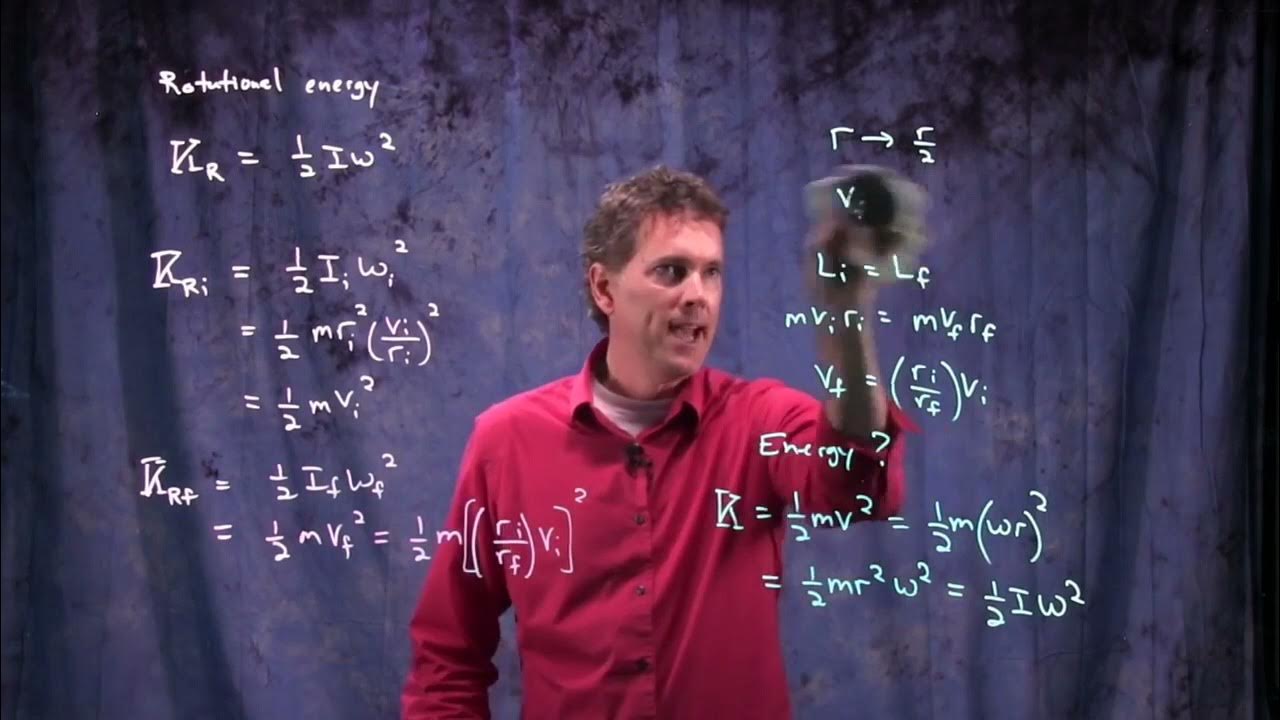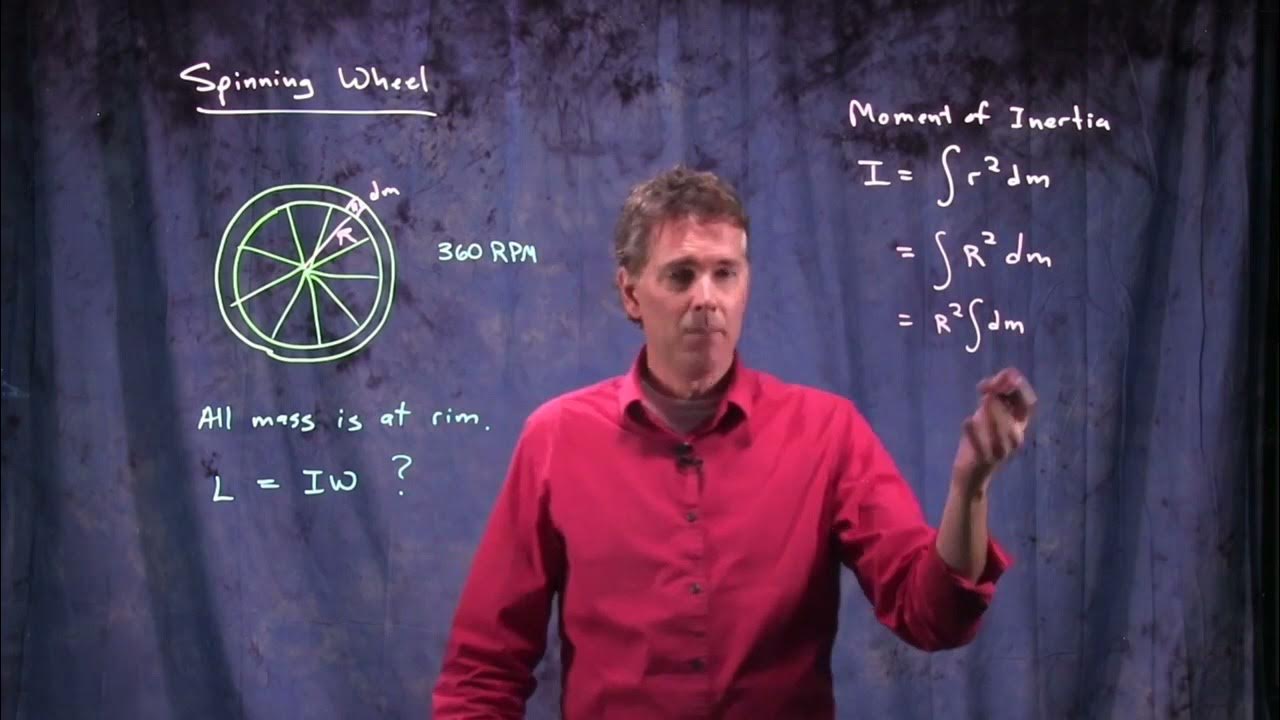Conservation of Angular Momentum | Physics with Professor Matt Anderson | M12-18
TLDRIn this educational transcript, Professor Anderson delves into the concept of angular momentum and its conservation. He explains that, much like linear momentum, angular momentum is conserved in the absence of external torques. Using the classic example of a ball on a string, he illustrates how the speed of the ball increases as the string's length is reduced. The principle is that the initial and final angular momenta must be equal, leading to the conclusion that when the radius is halved, the speed of the ball doubles. This demonstration effectively conveys the foundational principle of angular momentum conservation and its practical implications, offering a clear and engaging explanation that is both informative and accessible.
Takeaways
- 📐 **Conservation of Angular Momentum**: Angular momentum (L) is conserved in a system when there are no external torques acting on it.
- 🔄 **Definition of Angular Momentum**: Angular momentum is a vector quantity, represented by L, and is the rotational equivalent of linear momentum.
- ⚫ **System Consideration**: The initial and final states of the entire system must be considered to apply the conservation of angular momentum.
- 🧵 **Ball on a String Example**: The example of a ball on a string is used to illustrate the principles of angular momentum.
- 🏃 **Effect of Changing Radius**: When the radius (r) of the circular path of the ball is reduced, the speed (v) of the ball increases, following the conservation of angular momentum.
- 🔢 **Mathematical Relationship**: The final speed (v_final) is twice the initial speed (v_initial) when the radius is halved, calculated as v_final = (r_initial / r_final) * v_initial.
- ⚖️ **Conservation Equation**: The initial angular momentum (L_initial) must equal the final angular momentum (L_final), L_initial = L_final.
- 🚀 **Increasing Speed with Decreasing Radius**: As the radius decreases, the object's speed increases, following the conservation of angular momentum.
- ∞ **Extreme Case**: In the limit, as the radius approaches zero, the speed of the object would theoretically approach infinity, similar to the effect seen with black holes.
- 🤔 **Practical Implications**: The concept is important for understanding phenomena such as the increasing spin of a figure skater as they pull their arms in closer to their body.
- 📚 **Further Inquiry**: Professor Anderson encourages students to approach them for clarification if the concept is not clear, emphasizing the importance of understanding the principles discussed.
Q & A
What is the fundamental principle discussed in the script?
-The fundamental principle discussed in the script is the conservation of angular momentum.
Under which condition is angular momentum conserved?
-Angular momentum is conserved when there are no external torques acting on the system.
What does the conservation of angular momentum imply for a system?
-The conservation of angular momentum implies that the initial angular momentum (L_initial) must equal the final angular momentum (L_final) for the system.
What is the formula for angular momentum in the context of a ball on a string?
-In the context of a ball on a string, the formula for angular momentum is mvr, where m is the mass, v is the velocity, and r is the radius of the circular path.
What happens to the speed of the ball when the length of the string is halved, according to the conservation of angular momentum?
-When the length of the string is halved, the speed of the ball doubles, as long as there are no external torques acting on the system.
What is the implication of the angular momentum conservation principle in the example of the ball on a string?
-The implication is that as the radius (r) decreases, the velocity (v) of the ball must increase to maintain the same angular momentum, leading to a faster spinning ball.
How does the mass of the ball affect the final velocity when the string is shortened?
-The mass of the ball (m) does not affect the final velocity in this scenario because it remains constant and cancels out in the equation mv_initial * r_initial = mv_final * r_final.
What would happen to the speed of the ball if the string is continuously shortened?
-If the string is continuously shortened, the speed of the ball would increase indefinitely, following the principle that v_final = (r_initial / r_final) * v_initial.
What is the analogy used in the script to describe what happens when an object is pulled into a black hole?
-The analogy used is that as an object gets sucked into a black hole, it starts spinning faster and faster, similar to how the ball's speed increases as the string is shortened.
What would be the final speed of the ball if the string's length approaches zero?
-In the limit, as the string's length approaches zero, the final speed of the ball would theoretically approach infinity, indicating an infinitely fast spinning ball.
Why is it important to consider the entire system when applying the conservation of angular momentum?
-It is important to consider the entire system to account for all the contributing factors to the angular momentum. This ensures that the principle of conservation is accurately applied and the calculation of initial and final angular momentum is correct.
Can the conservation of angular momentum be applied to systems where there are external torques?
-No, the conservation of angular momentum principle strictly applies to systems where there are no external torques. If external torques are present, the angular momentum of the system will change.
Outlines
📚 Introduction to Angular Momentum Conservation
Professor Anderson introduces the concept of angular momentum and its conservation. He explains that, similar to linear momentum, angular momentum is conserved in the absence of external torques. The professor uses the example of a ball on a string to illustrate how angular momentum is maintained even when the radius of the spinning circle changes. When the string's length is halved, the speed of the ball doubles, demonstrating the conservation of angular momentum.
🔄 Effect of Radius on Angular Velocity
This paragraph delves into the relationship between the radius of rotation and the velocity of the spinning object. As the radius decreases, the angular velocity increases. The professor illustrates this by showing that if the radius is reduced to a third, the velocity would triple. He takes the concept to the extreme, suggesting that as the radius approaches zero, the velocity would theoretically become infinite, drawing a parallel to the increasing spin of matter as it falls into a black hole.
Mindmap
Keywords
💡Angular Momentum
💡Conservation of Angular Momentum
💡Torque
💡Linear Momentum
💡Elastic and Inelastic Collisions
💡Vector
💡Moment of Inertia
💡Ball on a String
💡Black Hole
💡External Forces
💡System
Highlights
Angular momentum is a foundational principle in physics, similar to the conservation of momentum.
Conservation of angular momentum applies to both elastic and inelastic collisions.
Angular momentum is conserved when there are no external torques acting on a system.
The conservation of angular momentum is represented by the equation L_initial = L_final.
The entire system must be accounted for in the calculation of angular momentum.
A simple example involving a ball on a string is used to illustrate the concept.
When the length of the string is halved, the speed of the ball doubles.
The angular momentum of a ball on a string is given by the formula mvr.
The mass (m) remains constant and cancels out in the final calculation.
The final speed (v_final) is calculated as v_initial multiplied by the ratio of the initial radius to the final radius.
In the example, as the radius is reduced to half, the speed increases by a factor of two.
If the radius continues to decrease, the speed increases proportionally.
In the limit, as the radius approaches zero, the speed would theoretically become infinite.
The phenomenon is likened to the increasing spin of matter as it falls into a black hole.
The example provides a clear understanding of the conservation of angular momentum in a practical scenario.
The lecture encourages students to seek clarification if they have any doubts about the concept.
The analogy of a ball on a string is a relatable and easy-to-understand model for explaining complex physics principles.
The lecture emphasizes the importance of considering the entire system when applying the conservation laws.
Transcripts
Browse More Related Video

Rotational Energy | Physics with Professor Matt Anderson | M12-17

Conservation of Angular Momentum

What Is Angular Momentum?

Angular Momentum - Basic Introduction, Torque, Inertia, Conservation of Angular Momentum

What IS Angular Momentum?

Angular Momentum of a Spinning Wheel | Physics with Professor Matt Anderson | M12-16
5.0 / 5 (0 votes)
Thanks for rating: